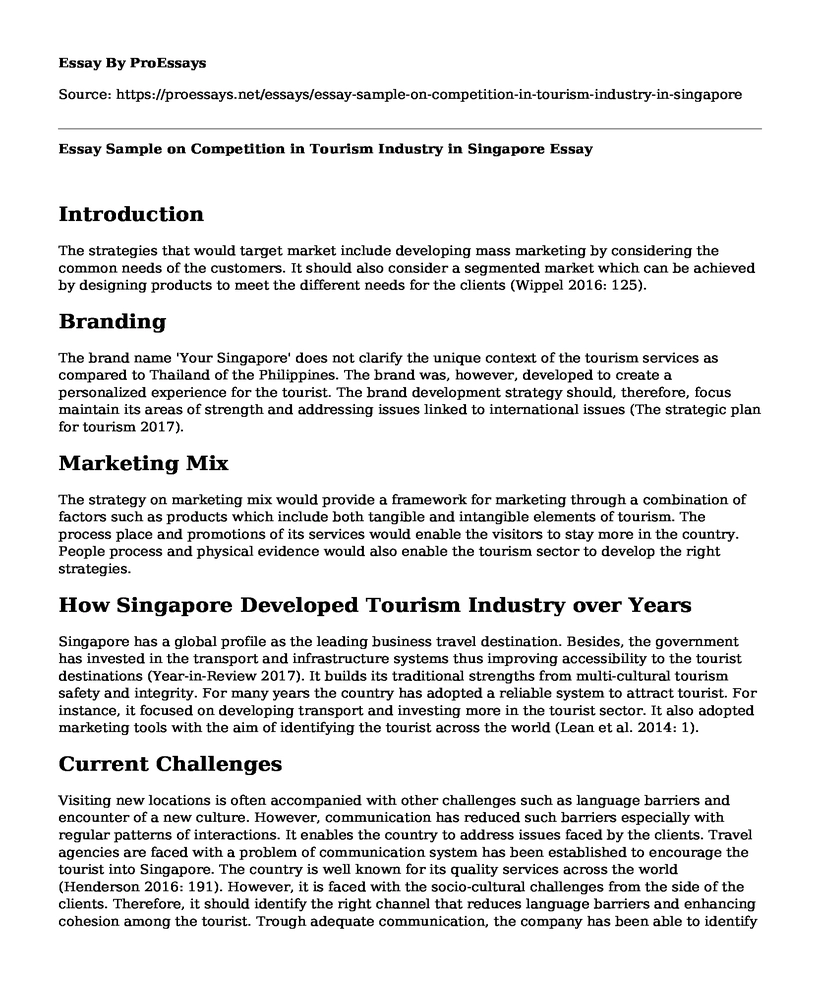Introduction
The strategies that would target market include developing mass marketing by considering the common needs of the customers. It should also consider a segmented market which can be achieved by designing products to meet the different needs for the clients (Wippel 2016: 125).
Branding
The brand name 'Your Singapore' does not clarify the unique context of the tourism services as compared to Thailand of the Philippines. The brand was, however, developed to create a personalized experience for the tourist. The brand development strategy should, therefore, focus maintain its areas of strength and addressing issues linked to international issues (The strategic plan for tourism 2017).
Marketing Mix
The strategy on marketing mix would provide a framework for marketing through a combination of factors such as products which include both tangible and intangible elements of tourism. The process place and promotions of its services would enable the visitors to stay more in the country. People process and physical evidence would also enable the tourism sector to develop the right strategies.
How Singapore Developed Tourism Industry over Years
Singapore has a global profile as the leading business travel destination. Besides, the government has invested in the transport and infrastructure systems thus improving accessibility to the tourist destinations (Year-in-Review 2017). It builds its traditional strengths from multi-cultural tourism safety and integrity. For many years the country has adopted a reliable system to attract tourist. For instance, it focused on developing transport and investing more in the tourist sector. It also adopted marketing tools with the aim of identifying the tourist across the world (Lean et al. 2014: 1).
Current Challenges
Visiting new locations is often accompanied with other challenges such as language barriers and encounter of a new culture. However, communication has reduced such barriers especially with regular patterns of interactions. It enables the country to address issues faced by the clients. Travel agencies are faced with a problem of communication system has been established to encourage the tourist into Singapore. The country is well known for its quality services across the world (Henderson 2016: 191). However, it is faced with the socio-cultural challenges from the side of the clients. Therefore, it should identify the right channel that reduces language barriers and enhancing cohesion among the tourist. Trough adequate communication, the company has been able to identify possible communication challenges faced by its clients.
Recommendations
Competition is one of the factors facing the tourism industry in Singapore especially with the growing market in Indonesia and China. However, the campaigns and advertising strategies conducted through the media have attracted international clients through social media platforms. Though the technology and innovative strategies, the tourism industry would develop a partnership with the hotel agencies and the neighboring countries to market the tourism industry (Phua and Miller 2014: 113). Expanding major utility facilities such as malls and hotels has contributed to the dynamic growth of the company. Branding has also contributed to efficient markets segmentation with the aim of targeting more tourists and addressing issues linked to competitiveness. It has focused on a large number of factors including the behavioral patterns of the tourist (Purwomarwanto and Ramachandran 2015: 325). It is through marketing and adoption of the rights communication strategies that the company would gain access to more market segmentation in the tourism sector.
References
Phua, V. and Miller, J.W., 2014. Gazing at Haw Par villa: Cultural Tourism in Singapore. Shima: The International Journal of Research into Island Cultures, 8(2).
Purwomarwanto, Y.L., and Ramachandran, J., 2015. Performance of the tourism sector with regard to the global crisis-a comparative study between Indonesia, Malaysia and Singapore. The Journal of Developing Areas, 49(4), pp.325-339.
Henderson, J., 2016. Integrated resorts and tourism: A Singapore perspective. Asia-Pacific Journal of Innovation in Hospitality and Tourism, 5(2), pp.191-208.
Lean, H.H., CHONG, S.H. and HOOY, C.W., 2014. Tourism and economic growth: Comparing Malaysia and Singapore. International Journal of Economics & Management, 8(1).Morrison, A.M., 2013. Marketing and managing tourism destinations. Routledge.
Wippel, S., 2016. Port and Tourism Development in Oman: Between Economic Diversification and Global Branding. In Under Construction: Logics of Urbanism in the Gulf Region(pp. 125-142). Routledge.
The strategic plan for tourism 2017 PST 2017,2022Year-in-Review 2017. A Bumper Year for Singapore Tourism
Cite this page
Essay Sample on Competition in Tourism Industry in Singapore. (2022, Nov 02). Retrieved from https://proessays.net/essays/essay-sample-on-competition-in-tourism-industry-in-singapore
If you are the original author of this essay and no longer wish to have it published on the ProEssays website, please click below to request its removal:
- Guy-Tri Foods - Marketing Analysis Example
- Supply Chain Aspects That Leads to the Success of Dell Essay
- Logistics and Supply Chain Management Paper Example
- Essay Example on Organizational Developments: Updating Outdated IT & Telephone Networks
- 83% Open-Minded: My Personality Traits Revealed - Essay Sample
- Unlocking the Potential of Human Resources in Organizations - Essay Sample
- Learner Screen Reading: The Use of Logos, Pathos and Ethos - Essay Sample







